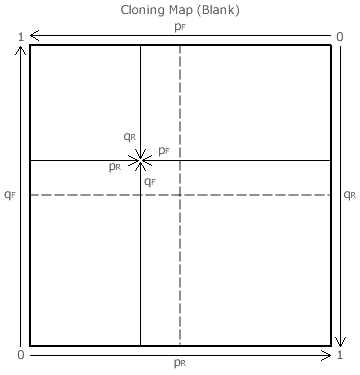Evaluations: Teaming Thresholds 1
GV Teaming Thresholds
Cloning within CHPV elections may result in vote splitting or in teaming depending upon the actual ballots cast. This is not surprising since CHPV uses a value of the common ratio that is halfway between the two extremes for GV. Vote splitting and teaming also occur in other positional systems. The Borda Count is highly vulnerable to teaming but does not experience vote splitting. At the other extreme is plurality (first-past-the-post). It is subject to vote splitting but is invulnerable to teaming. So how does the choice of common ratio effect the vulnerability of GV to teaming?
By keeping the weightings as functions of the common ratio and rank position, this relationship can be evaluated. As with CHPV previously, the easiest opportunity for gaining success through teaming in a GV election is when all of the candidates are tied. With one more vote, any candidate would win anyway with the smallest possible tally needed for victory and, with one less vote, that candidate would face a harder task. Therefore, in this threshold and tied scenario, each of the N candidates receive the same number of preferences at every rank position.
To keep the scenario as general as possible, let clone set A nominate a number of clones (K) to compete against the remaining M candidates (where N = K + M). It also issues a forward slate with its candidates listed from A1 down to AK. While all A supporters should follow this slate for maximum teaming effect, all non-A supporters should ideally reverse this slate for maximum opposition. If A was to reverse its slate (hoping to promote AK to victory instead of A1), then non-A supporters should similarly switch to the forward slate to thwart this inversion tactic. The following four proportions are therefore used to define how many ballots of each type are cast in the election.
- pF = Of those preferring A first, the proportion who rank the clone set in forward slate order
- pR = Of those preferring A first, the proportion who rank the clone set in reverse slate order
- qF = Of those not preferring A first, the proportion who rank the clone set in forward slate order
- qR = Of those not preferring A first, the proportion who rank the clone set in reverse slate order

How should non-A supporters respond to any attempt by A to cheat? More specifically, what values of q are needed to combat particular p values and hence thwart teaming?
By comparing the tally for candidate A1, and then the one for AK, with the common tally for any of the other tied non-A candidates, two 'teaming thresholds' result. As stated on the next two pages, these equations turn out to be functions of pF, pR, qF, qR, r and M. Note that the number of clones (K) is irrelevant as candidates can team against each other to the same extent by employing the same number of clones.
Supporters of A either rank their clone set in forward order or in reverse order so pF + pR = 1 for those preferring A as first preference. Similarly, for non-A supporters, qF + qR = 1 for those not preferring A first. Therefore, all possible valid combinations of the four ballot proportions can be represented on a 1 x 1 square map; as shown opposite.
Any point within the map is a distance pF from the right-hand side, pR from the left-hand side, qF above the bottom edge and qR below the top edge. All points outside the map are invalid as negative proportions of votes are impossible to cast.
Therefore, for any given common ratio (r) and any specified number of non-clone candidates (M), each point within the cloning map represents a unique cloning scenario and the cloning map itself contains all such possible scenarios.
Where all A supporters vote for the forward slate (pF = 1), the left-hand edge of the map represents the range of possible responses open to non-A supporters. With a reverse slate (pR = 1), the right-hand edge becomes the relevant range. In both cases, the desired fraternal clones are generated by A. If no slate is issued by A (pF = pR = 1/2) so that each identical clone gets the same average rank position and hence tally, then the central vertical dashed line then indicates the relevant range of options for non-A supporters.
Where non-A supporters respond with a reverse slate (qR = 1), a forward slate (qF = 1) or no slate (qF = qR = 1/2), then the bottom edge, the top edge or the central horizontal dashed line (respectively) represents their reply. So the position of a vertical (challenge) line is determined by A supporters while the position of a horizontal (response) line is controlled by non-A supporters. The point at which the appropriate vertical and horizontal (challenge versus response) lines intersect represents the actual combination of the four ballot types for the election.
Proceed to next page > Evaluations: Teaming Thresholds 2
Return to previous page > Evaluations: Clones & Teaming 7
